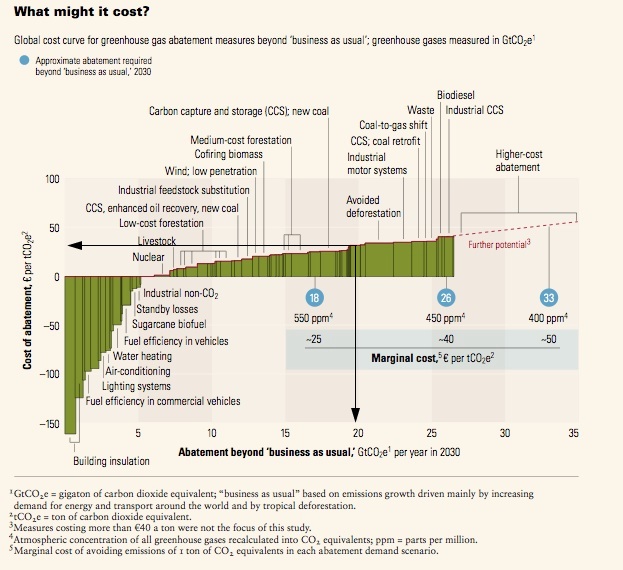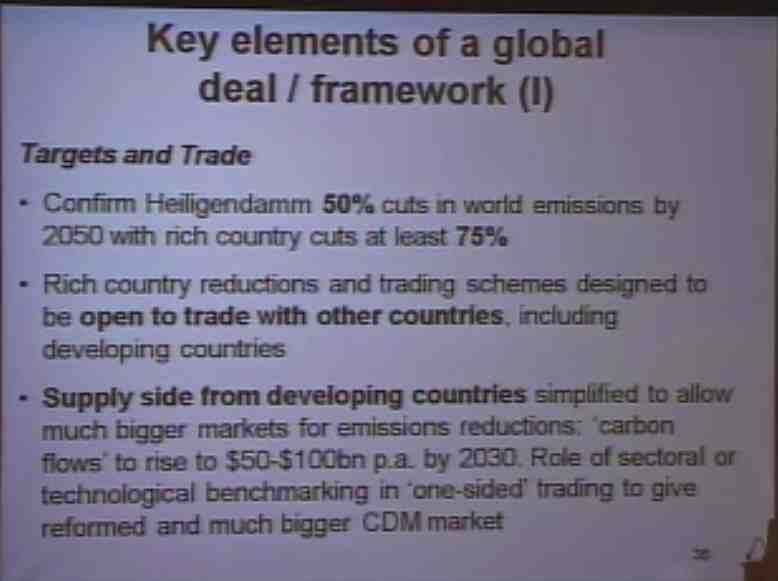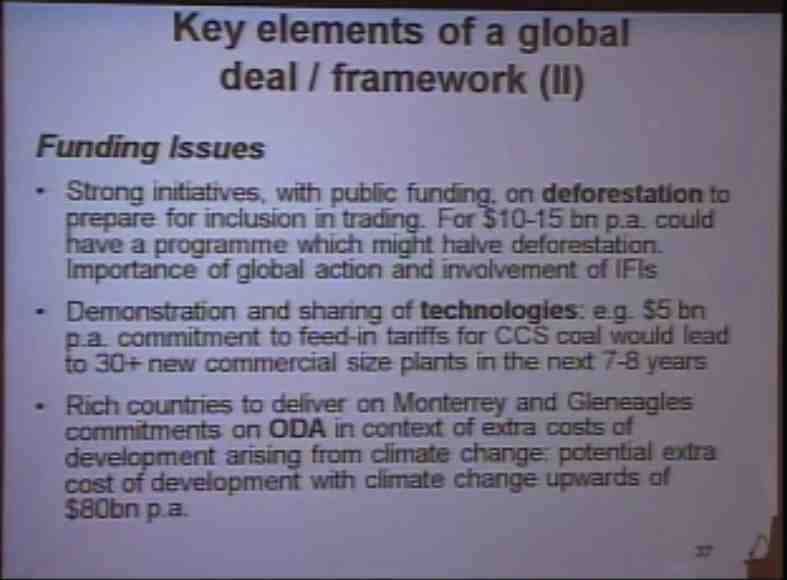
Source: Per-Anders Enkvist, Tomas Naucler, Jerker Rosander, "A cost curve for greenhouse gas reduction", McKinsey Quarterly 2007, Number 1 (in cache)
Cost of abatement (i.e. CO2 reduction) = annual additional operating cost (including depreciation) minus potential cost savings (e.g. from reduced energy consumption) divided by the amount of emissions avoided. Possible costs for implementing a system to realize the abatement approaches are not included.
The cost curve shows estimates of the prospective annual abatement cost (Euros per ton of avoided emissions of greenhouse gases), the abatement potential of these approaches (gigatons of emissions per year) and the marginal cost of an approach.
Arrows refer to an example pointed out by Nicholas Stern in this talk.
Examples for CO2e emission reductions by 26 gigatons per year (bright number in blueish disk), given by the authors of the McKinsey study (necessary reductions):
- The abatement cost for wind power should be understood as the additional cost of producing electricity with this zero-emission technology instead of the cheaper fossil-fuel power production it would replace. The abatement potential of wind power is our estimate of the feasibility volume of emissions it could eliminate at a cost of 40 Euros per ton or less.
Looked at another way, these costs can be understood as the price - ultimately, to the global economy- of making any approach to abatement cost competitive or otherwise viable through policy decisions.
A wide range of assumptions about the future cost and feasible deployment rates of available abatement measures underlie the estimates of their cost and significance. For example, the significance of wind power assumes that actions to abate greenhouse gases will have already begun across regions by 2008. The volumes in our model (and this graphics) should be seen as potential abatement, not as forcasts.
- Zero Life Cycle Costs
6 gigatons - or almost a quarter of the total abatement potential at a cost of 40 Euros a ton CO2e or less - could be gained through measures with zero or negative net life cycles cost. This potential appears in transportation and in buildings.
- Net Life Cycle Costs
As for measures that would have net costs, we found that around
- 35% of all potential abatements with a net cost of up to 40 Euros a ton pf CO2e involve forestry,
- 28% manufacturing,
- 25% the power sector,
- 6% agriculture, and
- 6% transportation.
- No New Technologies Required for 70% of the Reductions.
We found that some 70% of the possible abatements at a cost below or equal 40 Euros a ton of CO2e would not depend on any major technological developments, they rather involve very little technology (e.g. forstry or agriculture) or rely primarily on mature technologies. ... The remaining 30% of abatements depend on new technologies. ... The point is ... that low tech abatement is important in a 2030 perspective.
Nicholas Stern: "I'm not saying that McKinsey got these numbers right. The important numbers there they got wrong. The point is that you can construct options like that and go outward on that curve and say 'when this [e.g. 20 Gt CO2e, arrow pointing toward x-axis] is the kind of cut we aim for, you get the marginal cost [30 Euro per tCO2e, arrow pointing toward y-axis] of getting there' ... [i.e.] what it would cost you for the last bit [of the cut]."
Anmerkung: Wenn wir für die aufgeführten Maßnahmen die mit Pfeil ausgewiesenen 30 Euro pro Tonne CO2-Equivalent ausgeben müßten, würde das jeden Deutschen (mit einer durchschnittlichen CO2e-Emission von 10 ... 12 Tonnen pro Jahr) weniger als 1 Euro pro Tag kosten.)

